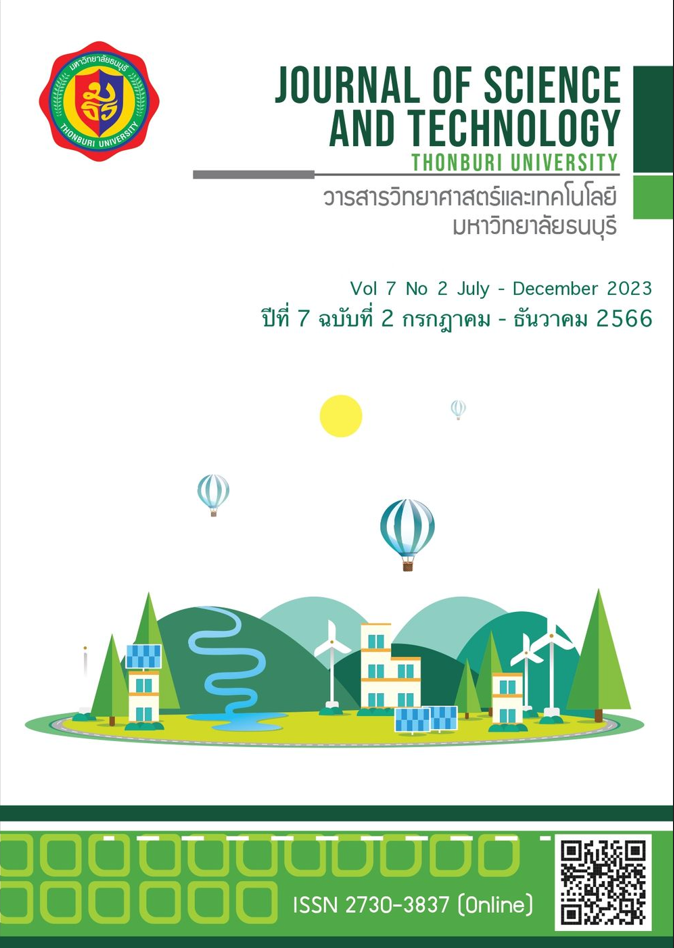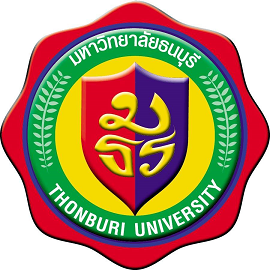การศึกษาสภาวะที่เหมาะสมของมีดกลึงโลหะผสม Al2O3–TiC ในการกลึงชิ้นงานเหล็กกล้าผสมเกรด AISI 4140
คำสำคัญ:
การออกแบบการทดลอง, ความหยาบผิว, การวิเคราะห์ความแปรปรวนบทคัดย่อ
งานวิจัยนี้มีวัตถุประสงค์เพื่อศึกษาการหาสภาวะเหมาะสมของมีดกลึงโลหะผสม Al2O3+Tic สำหรับการกลึงวัสดุเหล็กกล้าเกรด AISI 4140 ด้วยเครื่องกลึงอัตโนมัติ ทำการศึกษาปัจจัยการกลึงประกอบด้วยความเร็วตัดที่ระดับ 50 – 150 rev/min และอัตราป้อนที่ระดับ 0.2 - 0.6 mm/rev แตกต่างไปตามการทดลองแบบส่วนประสมกลาง (Central composite design, CCD) และทำการวิเคราะห์ผลการทดลองด้วยการวิเคราะห์ความแปรปรวน (ANOVA)
จากการศึกษาปัจจัยที่มีผลต่อการกลึงขึ้นรูปประกอบด้วยความเร็วตัดที่ระดับ 50 – 150 rev/min และอัตราป้อนที่ระดับ 0.2 - 0.6 mm/rev โดยพบว่าอัตราป้อนเป็นปัจจัยหลักที่มีผลต่อค่าความหยาบผิวอย่างมีนัยสำคัญ (P-value < 0.05)
ผลการวิเคราะห์สภาวะที่เหมาะสมของปัจจัยที่มีต่อค่าความหยาบผิวพบว่า ความเร็วตัดมีค่าเท่ากับ 50 rev/min และอัตราป้อนมีค่าเท่ากับ 0.20 mm/rev ค่าเฉลี่ยความหยาบผิวอยู่ที่ 0.345 µm
เอกสารอ้างอิง
Grzesik W. (2008). Influence of Tool Wear on Surface Roughness in Hard Turning Using Differently Shaped Ceramic Tools. Wear, 256, 327-335.
Paengchit, P., Saikaew, C. (2018). Effects of Cutting Speed and Feed Rate on Surface Roughness in Hard Turning of AISI 4140 with Mixed Ceramic Cutting Tool. Key Engineering Materials, 779, 153-158.
Singh, H. & Kumar, P. (2004). Tool Wear Optimization in Turning Operation by Taguchi Method. Indian Journal of Engineering & Materials Science, 11, 19-24.
Őzel, T., Karpt, Y., Figueira, L., & Davim, J.L. (2007). Modelling of Surface Finish and Tool Flank Wear in Turning of AISI D2 Steel with Ceramic Wiper Inserts. Journal of Materials Processing Technology, 189, 192–198.
Grzesik, W., Wanat, T., (2006). Surface Finish Generated in Hard Turning of Quenched Alloy Steel Parts Using Conventional and Wiper Ceramic Inserts. International Journal of Machine Tools & Manufacture, 46, 1988–1995.
Cai, K.F., McLachlan, D.S., Axen, N., & Manyatsa, R. (2002). Preparation, Microstructures and Properties of Al2O3–TiC Composites. Ceramics International, 28(2), 217-222.
Paengchit, P., & Saikaew, C. (2018). Effects of Cutting Speed and Feed Rate on Surface Roughness in Hard Turning of AISI 4140 with Mixed Ceramic Cutting Tool. Key Engineering Materials, 779, 153-158.
Aslantas, K., Ucun, I., & Çicek, (2012). A. Tool Life and Wear Mechanism of Coated and Uncoated Al2O3/TiCN Mixed Ceramic Tools in Turning Hardened Alloy Steel. Wear, 274–275, 442-451.
Mohd, A., Adnan, M. H. L., Baba, N. B., Selamat, Z. A., Rose, A. N. M., & Mohamed, S. B. (2020). Optimization of Surface Roughness and Tool Wear on AISI 4140 Using Coated Ni-YSZ for CNC Turning Process. 4th International Conference on Engineering Technology (ICET 2019), 1532, 1-11.
LAUZIER, J (2023). MachineMetrics. Retrieved from https://www.machinemetrics.com/blog/tool-wear
ดาวน์โหลด
เผยแพร่แล้ว
รูปแบบการอ้างอิง
ฉบับ
ประเภทบทความ
สัญญาอนุญาต
ลิขสิทธิ์ (c) 2023 Phachardit Paengchit

อนุญาตภายใต้เงื่อนไข Creative Commons Attribution-NonCommercial-NoDerivatives 4.0 International License.




